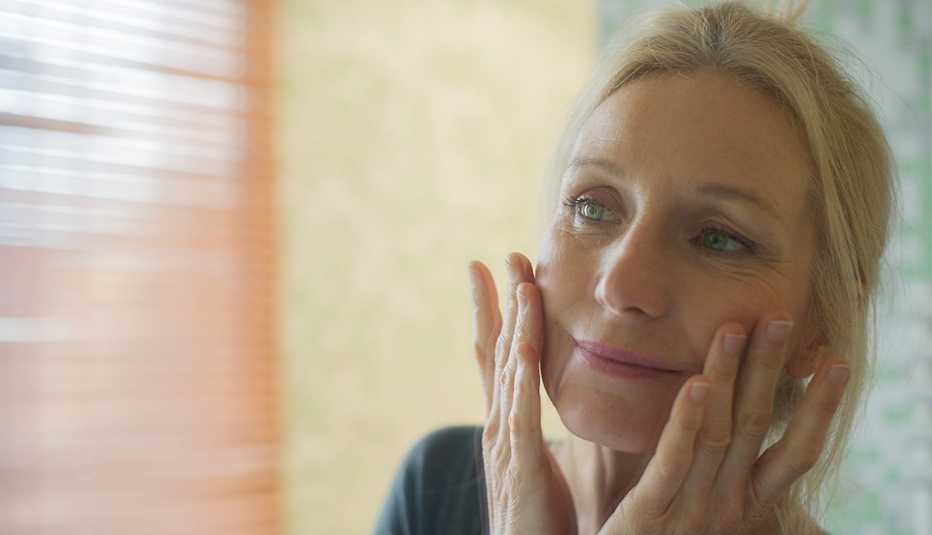4. Lasers
One way shadows can be shushed is with lasers, which can be used to stimulate collagen production. “When you thicken the skin, you see circles less,” says Lupo. They can also be used to target blood vessels underneath the skin.
Other ways to minimize dark circles
Try these over-the-counter treatments and lifestyle behaviors to banish the circles.
5. Treat your allergies
Seasonal allergies — and the nasal congestion that comes with them — can lead to a kind of clogging in the small veins underneath the eyes. When the blood vessels become blocked, blood starts to pool, causing them to dilate and become darker. (There's even a name for this: allergic shiners.) To stay in the clear, down an oral antihistamine or use a saline nasal spray.
Double up by using eye drops to get the allergens out of the mucous membranes in the eyes. And play keep-away with pollen and other allergens. Wear wraparound sunglasses when outside, and wash your hair and bedding more often. And resist the urge to rub your itchy eyes; rubbing can damage the walls of the blood vessels, causing them to break and release pigment. “Most people who do these things regularly see an improvement in vascular circles within 30 days,” Lupo says.
6. Smooth things over
Eye creams that contain vitamin K can help stimulate blood flow to prevent pooling around the eyes from leaky blood vessels. Caffeine is another ingredient to look for in skin products: “It helps constrict blood vessels to help temporarily with puffiness from lymphatic circulation — say, you had a long night, ate too much salt, or slept on your face and woke up a little puffy,” Nazarian says. Pop the product in the fridge. Anything that's cold will help constrict blood vessels temporarily, so you don't see as much discoloration. And yes, topical retinoids (like prescription Retin-A or an over-the-counter product) can help, too. With repeated use, they boost collagen production to increase skin volume and diminish blood vessels.
7. Watch the booze
“Limit alcohol intake,” Kaminska says. “It causes the small blood vessels under the skin to dilate and expand, making them more prominent.” What's more, that late-night glass of vino can dehydrate the skin, giving eyes a sunken look, which makes any discoloration lurking beneath the surface easier to see.
8. Sleep more
Poor sleep often leads to pallid skin, making any shadows you might have all the more conspicuous. Your sleep position matters too. “No one has circles as bad as a face sleeper, because fluid tends to pool in the space below your eyes making the area appear swollen,” says Lupo, who suggests sleeping on your back, with your head elevated on two or three pillows.
9. Try skin-lightening creams or serums
They can fade pigmentation over time. Hydroquinone is a potent lightening agent that essentially bleaches out darkened areas of skin. It also minimizes the activity of tyrosinase, an enzyme needed to make melanin. It's available by prescription at a concentration of about 4 percent or over the counter at lower concentrations. Kojic acid is another bleaching agent that works in much the same way, though it tends to be gentler on the skin.
Two ingredients you'll find in over-the-counter skin-care serums: licorice extract — which helps break up excess pigment and lighten discoloration — and vitamin C — an overachieving antioxidant that's brimming with brightening properties to improve a lackluster look and also neutralizes free radical damage, helping to prevent pigment from popping up in the first place. Before picking up a potion, keep in mind: “Care should be taken in this thin-skinned sensitive area,” says Campbell, who suggests consulting with a dermatologist to find the appropriate topical agent for your skin..
10. Shun the sun
That bright orange orb is bad news. Constant UV exposure can cause skin cells to produce more pigment. What's more, says Lupo, sunlight thins the collagen fibers in your dermis, so those pesky blood vessels show through more easily. Slip on sunglasses with UV protection, and when applying sunscreen (SPF 30 or higher) to your face, don't forget the vulnerable under-eye area.



































































More From AARP
7 Mistakes You May Be Making With Eye Drops
How to keep your eyes healthy and free of infection
What's Causing Your Puffy Lids and Watery Eyes?
There are a range of reasons and treatments for swelling and irritationWhat to Know About Conjunctivitis or Pink Eye
How to get relief from the common, contagious infection